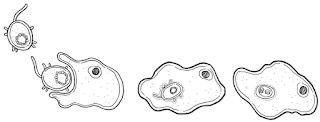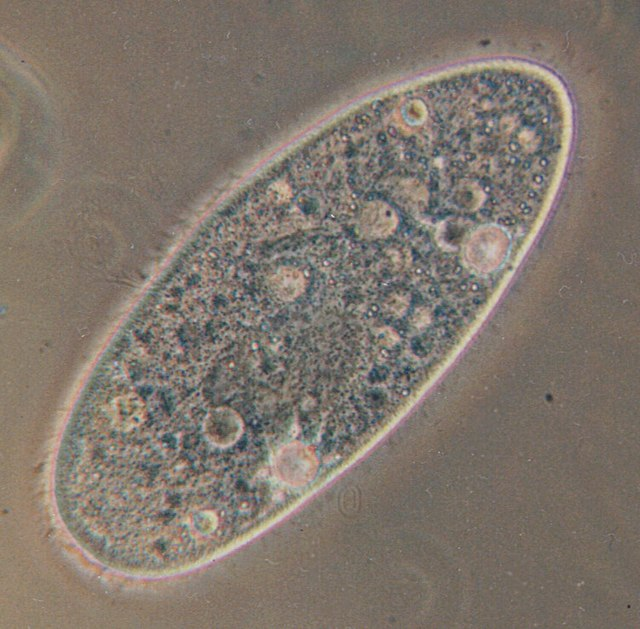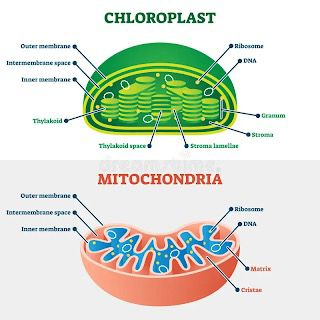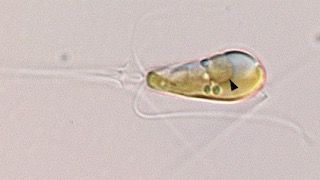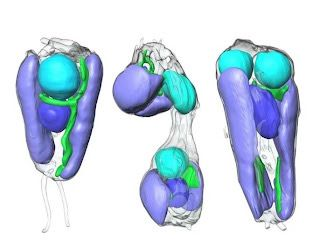The Emergence of Nitroplasts
Hari Rathan • 2024-09-24
The once in a billion year evolutionary phenomena happening under our noses
Evolutionary biology is filled with remarkable events with near impossible odds that have shaped the diversity of life on Earth. One such event, known as primary endosymbiosis, stands out due to its rarity and profound impact. Recorded only twice in our planet’s history, primary endosymbiosis is when one microbial organism engulfs another, leading to the creation of a new composite organism with never before seen capabilities.
The first occurrence of this event gave rise to mitochondria, essential organelles to release energy for eukaryotic cells. The second instance resulted in the formation of chloroplasts, which enabled plants to utilise sunlight through photosynthesis . Although some say it’s just a mere theory it’s accepted by most scientists as the leading theory to explain the origin of eukaryotic cells from prokaryotic organisms and it makes sense as it’s happening for the 3rd time.
The Concept of Primary Endosymbiosis
Primary endosymbiosis is a form of symbiosis as mentioned before is when one microbial organsim engulfs another, leading to a long-term, mutually beneficial relationship. Over time, the engulfed cell, or symbiont, becomes an integral part of the host cell, evolving into an organelle
To help readers who don’t understand the concept , imagine human kind needed to be inserted into an iron chamber to breathe but one day a random human swallowed a bee and then noticed that he could breathe without an iron chamber; cause the bee now acted like an organ to help us breathe (lungs) , they gave us never before seen abilities in exchange for nutrients and protection , now we don’t need to rely on external factors to breathe anymore . This process is distinct from other forms of symbiosis due to the permanent integration of the symbiont into the host's cellular machinery even carrying on to the offspring .
Another simplified explanation is the engine and chassis model this scenario is explain chloroplasts/plastits. The plastid is the engine that produces food for the car and the algal/plant cell is the car chassis . Sunlight (photosynthetic cell) and gasoline (chassis) are the fuels that drive these systems and produce beneficial products . Sugar for the photosynthetic cell( plant/algae) and thrust for the chassis. Byproducts are released as gas , heat or chemicals
Secondary and Tertiary Endosymbiosis
Secondary endosymbiosis occurs when a eukaryotic cell engulfs a cell that has already undergone primary endosymbiosis.They have more than two sets of membranes surrounding the chloroplasts. The chloroplasts of brown algae are derived from a secondary endosymbiotic event.
Tertiary endosymbiosis only the dinoflagellates have undergone this process, which is the engulfment of an alga containing a secondary plastid .
However as scientist’s its’s important to understand endosymbiosis is a theory, so it is widely accepted and the evidence points most strongly towards it, but it can always be contradicted in the future. Maybe just mention that somewhere
Experimentally Inducing Endosymbiosis
To understand the mechanisms behind the establishment of primary endosymbiosis, researchers conduct experiments that induce endosymbiosis . This involves mixing symbionts (organisms that live inside host cells) isolated from their symbiont-bearing host cells with symbiont-free host cells. This experimental approach allows scientists to observe the process of endosymbiosis in real time and understand how symbionts integrate into host cells.
Recent research using Paramecium, a type of single-celled eukaryote, and its symbiotic partners, such as the endonuclear symbiotic bacteria Holospora and the symbiotic green algae Chlorella, has provided significant insights into endosymbiosis. These organisms serve as model systems for studying host-symbiont interactions and the mechanisms of endosymbiosis.
Figure 1 – A paramecium cell / Wikipedia
Key Mechanisms in Endosymbiosis
Through extensive experimentation, researchers have identified several key mechanisms involved in the establishment and maintenance of endosymbiosis:
Engulfment and Integration: The process begins when a eukaryotic host cell engulfs a prokaryotic symbiont through phagocytosis. The engulfed symbiont then avoids digestion by the host's lysosomes, which are cellular organelles responsible for breaking down waste materials and cellular debris. Successfully evading degradation, the symbiont establishes a stable relationship with the host, receiving protection and nutrients.
Migration and Localization: Once inside the host cell, the symbiont migrates to specific locations within the host cytoplasm. Proper localization is essential for the symbiont to integrate effectively and establish a stable relationship with the host, receiving necessary protection and nutrients.
Species and Strain Specificity: The specificity of host-symbiont interactions is controlled by genetic and molecular factors. These factors ensure that only compatible symbionts are successfully incorporated into host cells, maintaining a functional and stable endosymbiotic relationship.
Life Cycle Control: For the symbiotic relationship to be maintained, the life cycles of both the host and symbiont must be synchronized. This coordination ensures that both organisms can thrive and reproduce without disrupting each other's functions.
Escape and Infection: Symbionts must be able to escape from the host cell to infect new host cells. This ability ensures the continuation and spread of the symbiotic relationship across generations of host cells.
Impact on Host Viability and Gene Expression: Symbionts can significantly affect the host cell's viability and gene expression. By influencing these factors, symbionts can alter the host's overall health and functioning.
Substances Involved in Endosymbiosis: Various substances, including proteins and signaling molecules, play crucial roles in the establishment and maintenance of endosymbiosis. These substances facilitate communication and integration between the host and symbiont.
Genomic Changes: Over evolutionary time, genes from the symbiont are transferred to the host's genome, solidifying the symbiotic relationship. This genomic integration leads to the evolution of new cellular functions and structures, such as organelles. The symbiont loses its independence and becomes a functional organelle within the host cell.
Historical Occurrences of Primary Endosymbiosis
Formation of Mitochondria
The first recorded instance of primary endosymbiosis occurred approximately 1.5 to 2 billion years ago, leading to the formation of mitochondria. This event involved an ancestral eukaryotic cell engulfing an alpha-proteobacterium. Mitochondria are now essential for aerobic respiration, providing energy in the form of adenosine triphosphate (ATP) through oxidative phosphorylation.
Key Impacts:
- Energy Production: Mitochondria enabled eukaryotic cells to utilize oxygen efficiently, vastly increasing their energy output.
- Evolutionary Advancements: The energy surplus provided by mitochondria facilitated the evolution of complex multicellular organisms.
Formation of Chloroplasts
The second occurrence of primary endosymbiosis happened around 1 to 1.5 billion years ago,
A heterotrophic eukaryote engulfed a cyanobacterium in an attempt to eat it, Instead of being digested, this photosynthetic prokaryote remained inside the cell Overtime, the captive prokaryote evolved into the chloroplasts and other plastids that we see in plant cells today. Thanks to the second primary endosymbiosis event plants exist on Earth by allowing eukaryotes to photosynthesise thus allowing plants and algae to convert sunlight into chemical energy.
Cause it’s primary symbiosis is a theory researchers have did tests on paulinella a photosynthetic amoeba that only gained it’s plastid 120 million years ago but evidence tells us the ancestors of paulinella lacked a plastid but consumed cyanobacterial prey . So we are confident the theory is valid.
Key Impacts:
- Photosynthesis: Chloroplasts enabled the conversion of solar energy into glucose, supporting the growth of autotrophic organisms.
- Oxygen Production: Photosynthetic activity of chloroplasts increased atmospheric oxygen levels, paving the way for aerobic life forms.
Evidence of Primary Endosymbioses
The strongest pieces of evidence that support that primary endosymbioses occurred lies in the unique traits of mitochondria and chloroplasts:
Mitochondria and chloroplasts contain their own DNA separate from the DNA material within the nucleus of the cell. Their DNA is also contained in a single plasmid, similar to bacteria, and different from the linear DNA in the cell.
Mitochondria and chloroplasts are both double membrane-bound organelles, which is likely a result of picking up a second membrane from their host when engulfed.
Mitochondria and chloroplasts both contain their own ribosomes and can synthesize proteins with them, supporting the idea that these were once autonomous free-living bacteria.
Mitochondria are closely related to the prokaryote alphaproteobacteria and chloroplasts are believed to have originated from cyanobacteria.
Mitochondria and Chloroplasts divide independently of the host’s cell cycle by a process of “binary fission”, similar to bacteria's division process.
Figure III. Diagram of a mitochondrion and a chloroplast demonstrating their unique features that support primary endosymbiotic theory.
Recent Discovery: A New Instance of Primary Endosymbiosis
In a groundbreaking discovery, scientists have observed a new instance of primary endosymbiosis in a species of algae. This event has led to the algae gaining the ability to fix nitrogen independently, a trait typically reliant on symbiotic relationships with nitrogen-fixing bacteria.
Figure III – An image of Braarudosphaera bigelowii
B. bigelowii has a nitroplast organelle, originated some 100 million years ago from a cyanobacterial endosymbiont called UCYN-A2, The algae species, currently under extensive study, exhibits unique characteristics that distinguish it from its relatives. The integration of a nitrogen-fixing bacterium into the algal cell has conferred new metabolic capabilities, enhancing its ecological adaptability.
Nomenclature - the word nitroplast derives from nitro – the organelle’s ability to fix nitrogen for it’s host and plast - living substance , cell or organelle
Mechanism of Nitrogen Fixation
Nitrogen fixation is the process of converting atmospheric nitrogen (N₂) into ammonia (NH₃), a form usable by living organisms. Typically, plants and algae rely on external nitrogen-fixing bacteria for this process. However, the newly discovered algae have incorporated the nitrogen-fixing bacterium as an organelle, enabling autonomous nitrogen fixation.
Figure IV - X-ray images of Braarudosphaera bigelowii
At different stages of cell division. The newly identified nitroplast is highlighted in cyan, the algae nucleus is blue, the mitochondria are green, and the chloroplasts are purple (Image: Valentina Loconte/Berkeley Lab)
Key Impacts:
- Nutrient Independence: The algae can now thrive in nitrogen-poor environments, expanding its ecological niche.
- Ecological Implications: This development could influence nutrient cycles and energy flows in aquatic ecosystems.
Evolutionary Significance of Primary Endosymbiosis
Genetic Innovation
Primary endosymbiosis represents a significant source of genetic innovation. The transfer of genes from the symbiont to the host genome introduces new metabolic pathways and capabilities. This genetic integration can lead to the emergence of novel traits, enhancing the host's adaptability and evolutionary potential.
Evolution of Complex Life Forms
The advent of mitochondria and chloroplasts through primary endosymbiosis was pivotal in the evolution of complex life forms. Mitochondria provided the energy required for the development of larger and more intricate organisms, while chloroplasts enabled the harnessing of solar energy, supporting the growth of diverse autotrophic life forms.
Ecological Impact
The integration of new metabolic functions through primary endosymbiosis can have far-reaching ecological consequences. For instance, the development of photosynthesis in chloroplasts transformed the Earth's atmosphere, increasing oxygen levels and supporting the proliferation of aerobic organisms. Similarly, the new nitrogen-fixing capability in the algae species could alter nutrient dynamics in aquatic ecosystems.
Reasons for endosymbiosis being so rare
1. Immune Responses and Cellular Defense Mechanisms
- Host immune systems: Most organisms have evolved sophisticated immune systems that protect against infection by foreign bodies. When one organism tries to invade another, the host’s immune response often works to eliminate the invader before any symbiotic relationship can develop. In multicellular organisms, especially, this defense is highly effective.
- Cellular defenses: Even within single-celled organisms, there are internal defense mechanisms like restriction enzymes or other means to degrade foreign genetic material or cells.
2. Compatibility Issues
- Genetic incompatibility: For a stable endosymbiotic relationship to form, the two organisms need to be genetically compatible in ways that allow both of them to benefit. Many potential endosymbiotic partners would simply be incompatible due to differences in biochemical processes, energy usage, or communication signals.
- Metabolic integration: The two organisms must find a way to share metabolic products efficiently. For example, in the case of mitochondria, the host cell had to learn how to harvest energy from the mitochondrial processes, and the mitochondria had to adapt to being dependent on the host cell for certain resources. Such metabolic integration is complex and difficult to achieve.
3. Evolutionary Barriers
- Selection pressures: For endosymbiosis to evolve, there must be selective pressure favoring the symbiotic relationship over independent existence. This is often not the case, as many organisms are well-adapted to their environments and don't require such radical changes.
- Gene transfer issues: In successful cases of endosymbiosis, like the origin of mitochondria and chloroplasts, part of the endosymbiont’s genome has typically been transferred to the host's genome. This process of horizontal gene transfer is relatively rare and error-prone, making it a significant hurdle.
4. Stability of the Relationship
- Evolutionary conflict: Even if an endosymbiotic relationship forms, it must be stable and mutually beneficial over long periods. Conflicts can arise if the interests of the host and the endosymbiont diverge. For example, if the endosymbiont replicates too quickly, it could harm the host, or vice versa. If the relationship becomes too parasitic, it might be selected against.
- Cost of maintenance: Maintaining an endosymbiotic relationship can be energetically costly. The host has to provide resources for both itself and the endosymbiont. If environmental conditions change, this cost may outweigh the benefits, making it less favorable for the host to maintain the relationship.
5. Environmental Factors
- Lack of opportunity: The physical and ecological environments must also provide the conditions necessary for endosymbiosis to occur. Organisms need to encounter each other frequently enough for symbiotic relationships to evolve. In environments where organisms are too isolated or conditions are not stable, endosymbiosis is less likely to happen.
6. Chance Events
- Rarity of beneficial mutations: The establishment of an endosymbiotic relationship is, to a large extent, a matter of chance. Mutations that allow for the integration of an endosymbiont into a host cell are rare. Even when such mutations arise, they must confer a strong enough survival advantage to be favored by natural selection.
Scientific Implications and Future Research
Understanding Symbiosis
The recent discovery of primary endosymbiosis in algae offers a unique opportunity to study the mechanisms and evolutionary dynamics of symbiosis. Understanding how the integration of the nitrogen-fixing bacterium occurred and how it has been maintained can provide insights into the process of organelle formation and the evolution of complex life.
Genetic and Genomic Studies
Further genetic and genomic studies on the algae species and its symbiont can reveal the extent of genetic transfer and integration. Mapping the genomes of both the host and the symbiont can identify key genes involved in nitrogen fixation and other metabolic pathways, shedding light on the genetic basis of primary endosymbiosis.
Ecological and Environmental Impacts
Investigating the ecological impacts of the new nitrogen-fixing algae can help predict potential changes in aquatic ecosystems. Understanding how this capability affects nutrient cycles, primary productivity, and species interactions can inform conservation and management strategies for aquatic environments.
Biotechnology Applications
The ability of the algae to fix nitrogen independently has potential biotechnological applications. Harnessing this capability could lead to the development of new biofertilizers, reducing the reliance on chemical fertilizers and promoting sustainable agriculture.
Medical Applications
The further study of the impact of primary endosymbiosis on mitochondria helps doctors and researchers understand mitochondrial diseases and their fundamental mechanisms. This knowledge can be used to create new treatments and find new interventions for those suffering from genetic mitochondrial dysfunction.
Wolbachia is a bacterial endosymbiont commonly found in insects and some nematodes. In dermatology, Wolbachia has been identified in lice (Pediculosis humanus) and bedbugs (Cimex lectularius), where it plays essential roles in the survival and reproductive capabilities of these ectoparasites. For instance, in lice, Wolbachia facilitates the production of essential B vitamins, including pantothenic acid, which the lice cannot synthesize themselves but are critical for their growth. Similarly, in bedbugs, Wolbachia helps produce biotin and riboflavin, essential for reproduction and development
By understanding how endosymbiotic bacteria contribute to ectoparasite survival, new treatments targeting these microorganisms could be developed to control conditions
Astrobiology and Origin of Life
Endosymbiotic theory helps give a glimpse into the early life of microorganisms over a billion years ago, and can provide a model for understanding how complex life evolves under unique circumstances. Understanding primary endosymbiosis can provide a lens in the search for extraterrestrial life or other complex organisms in our galaxy.
Paleontology
Insights from primary endosymbiosis can provide a wealth of knowledge for interpreting fossils and clues for the cellular structures and metabolic capabilities of early animals.
References
- Symbiogenesis - Wikipedia
- Mechanisms for establishing primary and secondary endosymbiosis in Paramecium - PubMed
- 3.7: Primary Endosymbiosis - Biology LibreTexts
- Mechanisms for establishing primary and secondary endosymbiosis in Paramecium - PubMed video
- https://www.albert.io/blog/endosymbiosis-ap-biology-crash-course/#:~:text=In%20addition%20to%20the%20lack,to%20survive%20on%20their%20own.
- https://pubmed.ncbi.nlm.nih.gov/29194776/
See More Posts
Copyright © 2021 Govest, Inc. All rights reserved.
